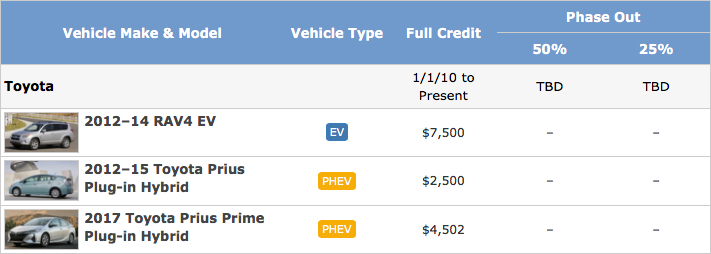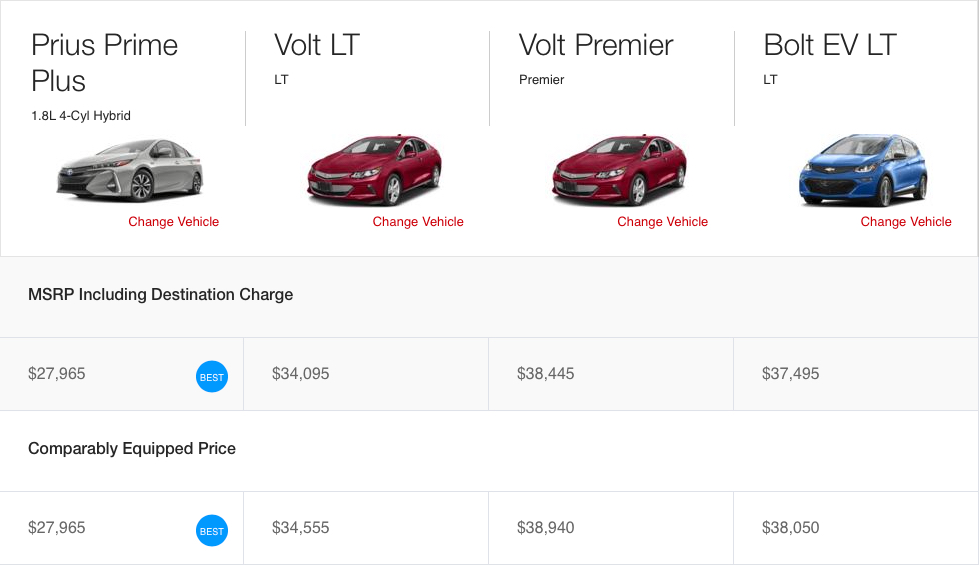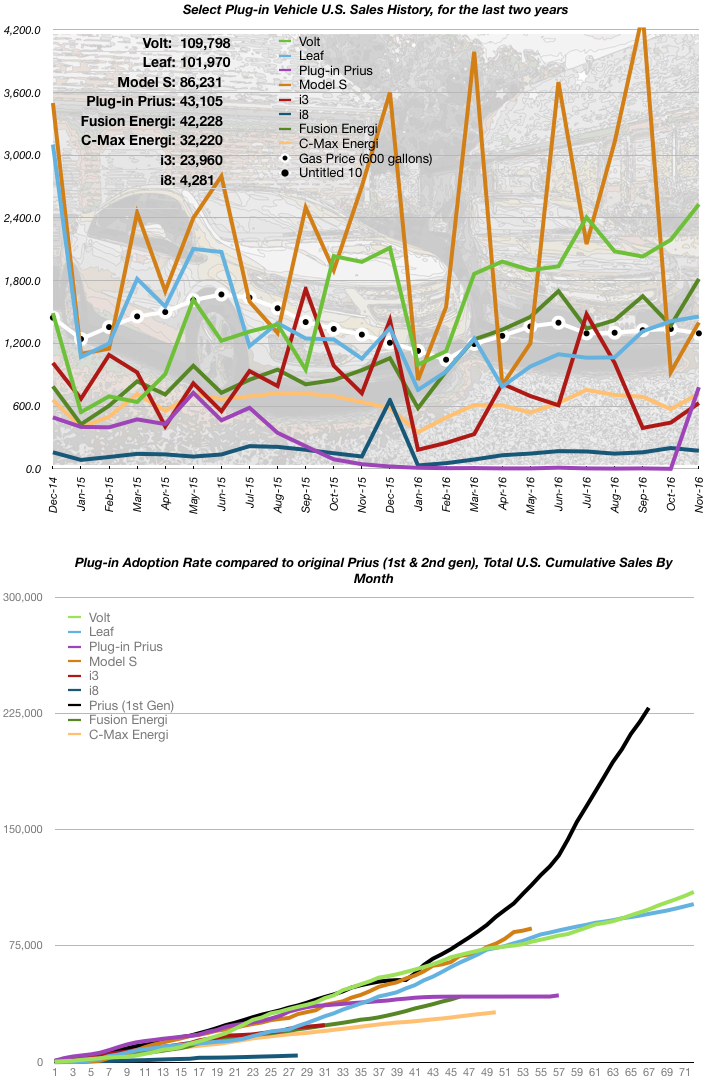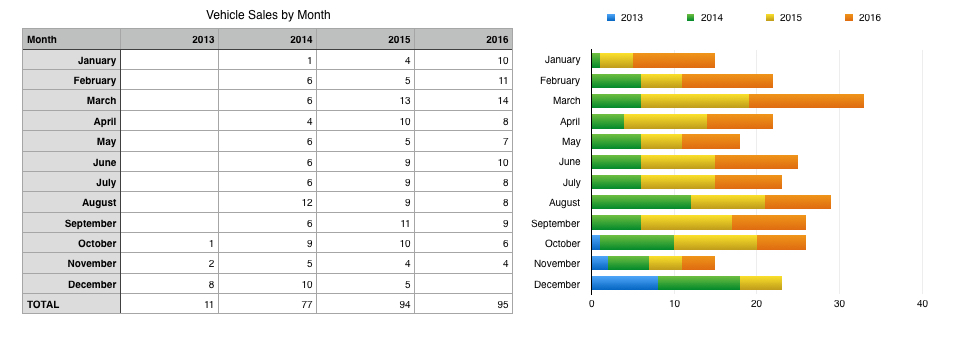In November 2016, plug-in vehicle sales were up, across the board, once again with one notable exception: The BMW i8. The i8 is obviously a niche, performance hybrid, but take a look at the first two charts below. The i8 had consistently been the poorest-selling of the vehicles I track, until October 2015, when the plug-in Prius, due for a refresh, dropped to eleven or fewer units per month and stayed there until last month. What happened last month? The Prius Prime began shipping, replacing the plug-in Prius. Sales jumped from zero to 781 units, once again, placing the Prius above the lowly i8. In the lower chart (cumulative sales), we can see that the i8 barely registers at all. We can also observe the plug-in Prius, started at an adoption rate similar to other plug-ins, but around the 29th month the curve levels off, as sales began a 28 month decline.

 Sales of Prius Prime will be interesting, going forward. The Prius Prime has the Prius name going for it, but its 25 mile EV range does not measure up, in today’s market. The Chevy Volt boasts 53 miles of electric range and the new all-electric Chevy Bolt EV has 238 miles of range. Toyota’s website seems to be a bit disingenuous, as the default comparison page (image above) compares the Volt Premier to the Prius Prime, illustrating a large price discrepancy. However, once I loaded the Volt LT and Bolt EV into the mix, the price difference between the Prius and the Volt (LT) is reduced to $6,130.
Sales of Prius Prime will be interesting, going forward. The Prius Prime has the Prius name going for it, but its 25 mile EV range does not measure up, in today’s market. The Chevy Volt boasts 53 miles of electric range and the new all-electric Chevy Bolt EV has 238 miles of range. Toyota’s website seems to be a bit disingenuous, as the default comparison page (image above) compares the Volt Premier to the Prius Prime, illustrating a large price discrepancy. However, once I loaded the Volt LT and Bolt EV into the mix, the price difference between the Prius and the Volt (LT) is reduced to $6,130.
But wait! There’s more: The Prius Prime, due to its smaller battery pack, does not get the full $7,500 in tax incentives that the Chevys get. The Prius gets its owners a tax credit of only $4,502. That reduces the effective cost of the four vehicles as follows:
- Prius Prime: $23,463
- Volt LT: $26,595 (+$3,132)
- Volt Premier: $30,945 (+$7,482)
- Bolt EV: $29,995 (+$6,532)
Will the lower price be enough to coax buyers away from the Chevrolet offerings? Time will tell, but the Volt’s electric range (more than double the Prius’) will allow many more drivers to pass by the gas station without stopping. Obviously, as a five-time Volt owner and a Chevy salesperson, I am biased. That being said, I have been saying, for some time now, that the lower EV range of the Prius would only be acceptable until Prius shoppers got a little EV experience/knowledge. The name of the game in EVs is range, range, range (and acceleration). Looking back, the plug-in Prius has bested the Volt’s monthly unit sales only four times (out of fifty-seven months of availability) and hasn’t posted a better monthly total since May 2014. Toyota has been betting on hydrogen fuel cell vehicles, while neglecting the pure EV market. Now, realizing their error, they have announced they will be producing EVs in the future.
On a side note, I was in our dealership’s new EV / Hybrid Center, meeting with interior designers and building contractors, when I noticed two men walking up and down, in front of the Volt inventory. I excused myself to go help them, only to find they both worked for Toyota. One of them was obviously from Japan. We chatted for a while and they asked how many pickups we had in stock. We have several hundred. This amazed them, as they were used to seeing tens of Tundra pickups in an average Toyota dealership’s inventory. I’m not sure why they picked Classic Chevrolet as a place to look around, but I’d like to think they were curious about a Chevy dealer having an EV / Hybrid Sales Center in an oil-rich state like Texas…
I believe the market has matured and buyers want more range. I know I do! In my opinion, Toyota is going to have to step up their game to compete with General Motors, BMW and Nissan. Here are the November 2016 sales figures, compared to the previous month:
- Chevy Volt: UP 16% (2,531 vs. 2,191) *highest monthly sales since August 2013!
- Nissan Leaf: UP 3% (1,457 vs. 1,412)
- Plug-in Toyota Prius: They’re baaaack! (781 vs. 0)
- Tesla Model S: UP 51% (1,400 vs. 925) **estimated
- BMW i3: UP 42% (629 vs. 442)
- BMW i8: DOWN 13% (173 vs. 199)
- Ford Fusion Energi: UP 32% (1,817 vs. 1,372)
- Ford C-Max Energy: UP 26% (721 vs. 571)
In November, the average price of gasoline dropped by 7 cents, to $2.16 per gallon, in the U.S. It dropped pretty steadily, until November 27th, bottoming out at $2.12, and then rose steeply for the remainder of the month, ending around the average price of $2.16 for the month. November started terribly for me, with ZERO sales in the first half of the month. I ended the month with four sales for November, not a good month for me at all, but a pretty typical November. Last month, I mentioned I had never sold a vehicle in the November 1st through November 7th timeframe. That pattern was repeated this year, augmented by another zero week November 8th through 15th. I definitely will be taking the first week of November off next year!
November started terribly for me, with ZERO sales in the first half of the month. I ended the month with four sales for November, not a good month for me at all, but a pretty typical November. Last month, I mentioned I had never sold a vehicle in the November 1st through November 7th timeframe. That pattern was repeated this year, augmented by another zero week November 8th through 15th. I definitely will be taking the first week of November off next year! My sales, by vehicle, included two Volts, but not a single Silverado 1500, increasing the previous Volt lead of one unit, to three units, over the pickup.
My sales, by vehicle, included two Volts, but not a single Silverado 1500, increasing the previous Volt lead of one unit, to three units, over the pickup.
Plug-in sales, compared to the same month a year ago, were mixed:
- Chevy Volt: UP 28% (2,531 vs. 1,980)
- Nissan Leaf: UP 38% (1,457 vs. 1,054)
- Plug-in Toyota Prius: UP 1,675% (781 vs. 44)
- Tesla Model S: DOWN 48% (1,400 vs. 2,702)
- BMW i3: DOWN 13% (629 vs. 723)
- BMW i8: UP 47% (173 vs. 118)
- Ford Fusion Energi: UP 92% (1,817 vs. 944)
- Ford C-Max Energi: UP 13% (721 vs. 639)
Finally, I’ve been looking at my income versus sales volume. Although I surpassed last year’s total unit sales, by the end of November this year, my income is much lower than it was last year. Much of this was due to advertised sale prices, which reduced many of my sales to a “mini,” as it is known in the world of auto sales. A “mini” is a vehicle sale resulting in the minimum commission paid by the dealership. How does this happen? Our newspaper and website ads compete with dealers in the area. All the dealerships have been racing to the bottom in pricing, in order to bring in potential buyers. General Motors has also offered great incentives, like 10% off Corvettes (which my dealership increased to 20%, eliminating the profit, on which I am compensated). GM also discounted Silverados by 20%, to drive traffic to the dealers. It’s been a fantastic few months for those in the market to purchase a new vehicle, but it’s been hell on salespeople.


